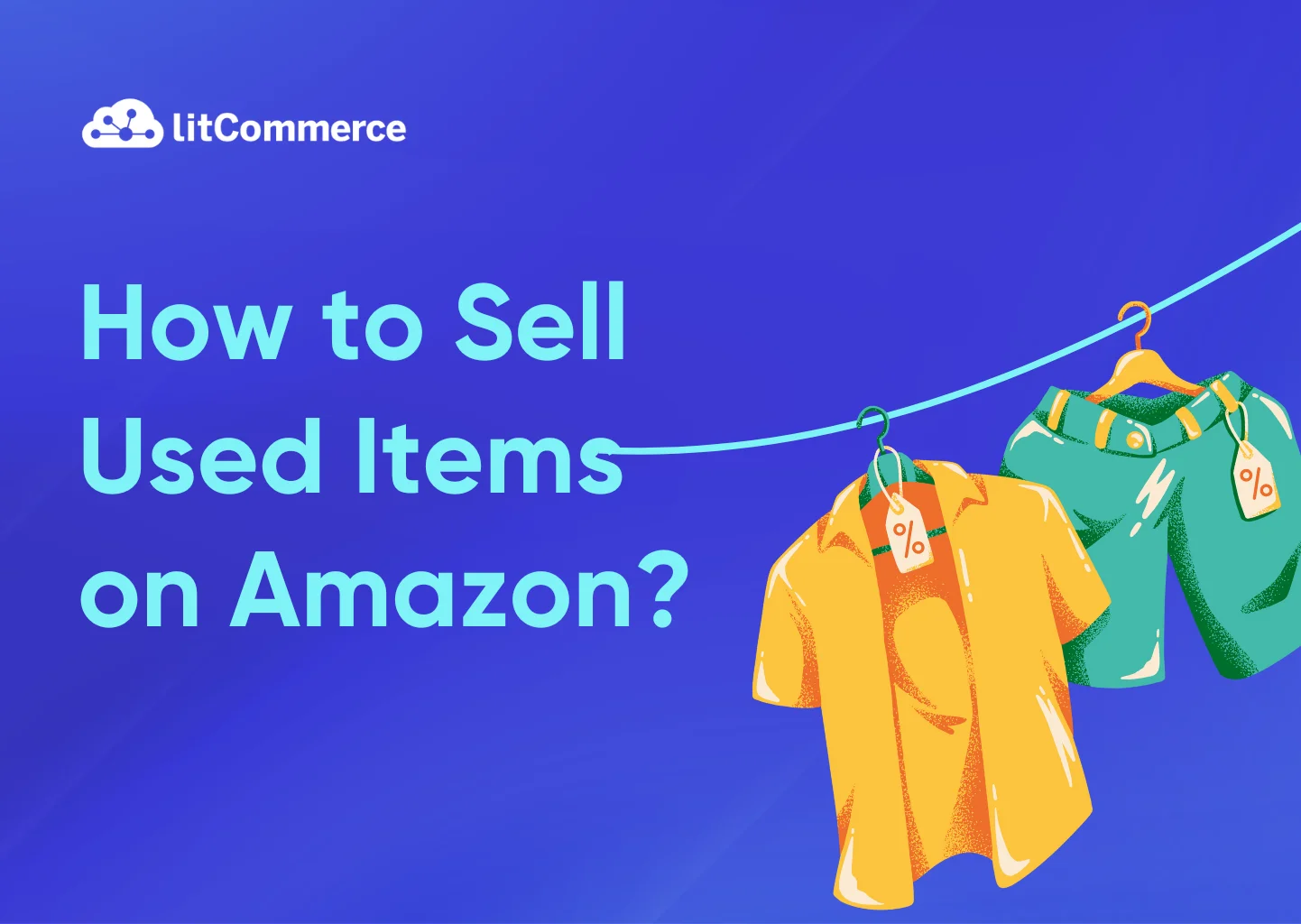Can we sell used items on Amazon? Definitely, yes, you can sell through the Amazon marketplace. Many sellers offer pre-owned books, electronics, and other goods. Speaking of how to sell used items on Amazon, you need to:
- Step 1: Understanding Amazon’s marketplace for used items
- Step 2: Find used items
- Step 3: Setting up your Amazon seller account
- Step 4: Listing our used items on Amazon
- Step 5: Price your used items
- Step 6: Fulfill your orders
- Step 7: Handle return and refund
- Step 8: Optimize your sales performance
That’s the brief guide, but each step includes many small actions. Some steps, such as listing a used item or choosing a price, maybe confusing without detailed instructions.
This guide aims to equip you with the knowledge you need to start selling used items on Amazon. Let’s walk through each step now and turn your preloved items into sales!
How to Sell Used Items on Amazon? – This 8-Step Guide Can Save Your Time
To get started selling used items on Amazon, you need to know the market, find items, create a seller account, list your items accurately, and more. To learn the details step by step, check now!
Step 1: Understanding Amazon’s marketplace for used items
Your journey of how to sell Amazon used items should start by understanding the regulations Amazon is setting for this market.
1.1. Categories allowed for used items
Not everything under the sun can be sold as “used” on Amazon. They have specific categories where used listings are accepted. This ensures a consistent and reliable shopping experience for customers. Some popular categories for used items include:
- Amazon Kindle
- Books
- Camera & photo
- Cell Phones & Accessories
- Consumer electronics
- Amazon device accessories
- Home & Garden
- Industrial & Scientific
- Kindle accessories and Amazon Fire TV accessories
- Major appliances
- Music
- Musical instruments
- Office products
- Outdoors
- Personal computers
- Pet supplies
- Software
- Sports
- Tools & home improvement
- Video, DVD & Blu-ray
- Video games
Pro tip: If you’re unsure whether your item qualifies, search for similar used items on Amazon. If you find comparable listings, you’re good to go!
1.2. Condition guidelines
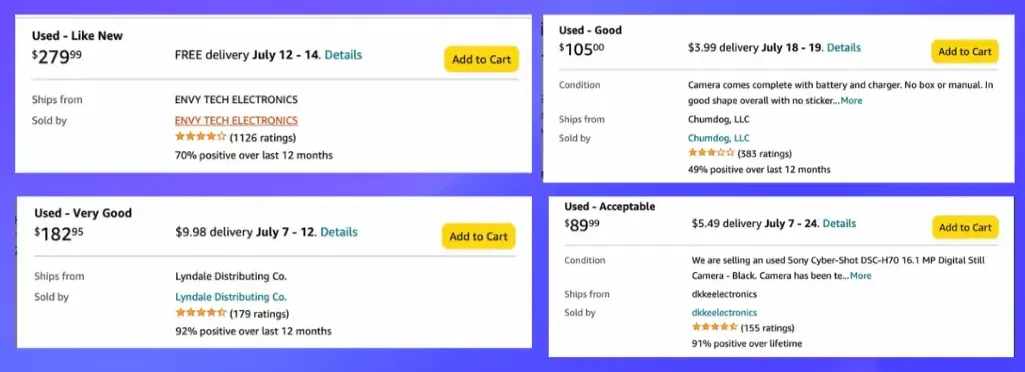
Amazon has strict condition guidelines to ensure buyers know exactly what they’re getting. You need to carefully learn these guidelines when exploring how to sell used items on Amazon.
Here’s a breakdown of the four main condition categories for used items:
- Used – like new: The item appears virtually brand new, with minimal to no signs of wear. It may be missing the original packaging but should include all original parts and manuals.
- Used – very good: The item shows some signs of wear but is fully functional. There may be slight cosmetic blemishes or minor imperfections, but they shouldn’t affect functionality.
- Used – good: The item is generally functional but may show moderate wear and tear. Scratches, dents, or missing parts (that don’t affect core functionality) might be present.
- Used – acceptable: The item is functional with significant wear and tear. It may have major cosmetic damage or missing parts, but it should still work as intended.
Pro tips: Being honest and accurate about the condition of your item is crucial. Why’s that? Exaggerating the condition can lead to unhappy customers and negative reviews, damaging your seller’s reputation.
1.3. Selling methods
There are three main ways to sell used items on Amazon:
#1 – Use Amazon Trade-in program
This is a hassle-free option for commonly traded items like books, electronics, video games, and select consoles. Here’s how it works:
- Get a quote: Search for your item on the Amazon Trade-in website. Enter the product’s condition (good, very good, etc.) and receive an instant quote.
- Ship your items for free: Once you accept the quote, Amazon provides a pre-paid shipping label. Pack your items securely and send them off at no cost.
- Get paid quickly: After Amazon receives and verifies your items, they’ll deposit the quoted amount directly into your Amazon account or issue a gift card, whichever you prefer.
However, the trade-in value may be lower than what you could get selling directly. Plus, you’re limited to specific product categories.
#2 – Sell through Amazon Renewed (for qualified sellers)
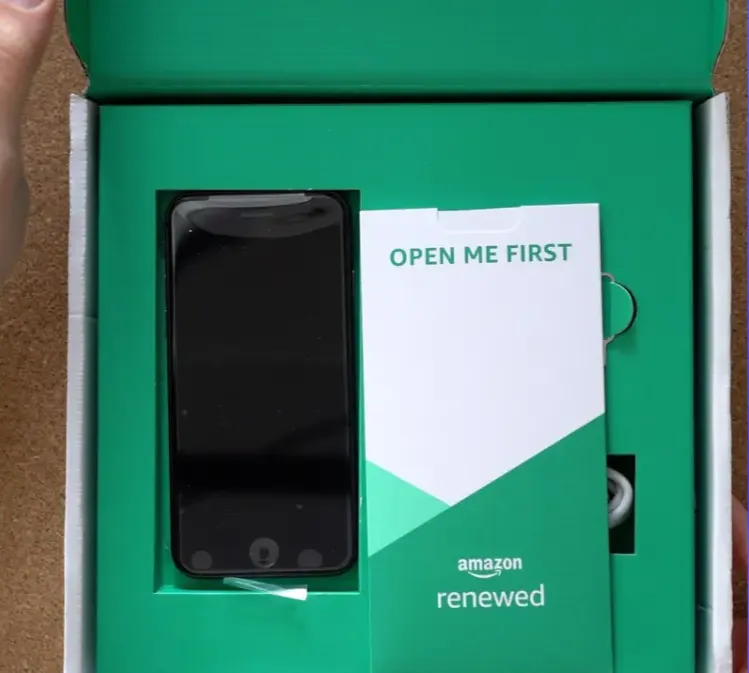
This program is for experienced sellers who can refurbish and pre-inspect used items to meet Amazon’s high standards. Amazon Renewed products come with a warranty and qualify for Amazon Prime benefits, making them more attractive to buyers.
If you have a larger inventory of high-value items and the ability to refurbish them, Amazon Renewed could be a more profitable long-term route.
However, the application process is selective, and sellers have less control over pricing. Furthermore, to sell used items on Amazon Renewed, you need to meet the following conditions:
- High sales volume: Prove at least $50,000 in refurbished product purchases within 90 days (or $50,000 in home/garden, tools, or kitchen within 180 days).
- Great seller performance: Maintain a low Order Defect Rate (below 0.8%) for the past 90 days on Amazon.
- Detailed product listings (for manufacturer-refurbished items without warranty): Submit 8 high-quality photos showcasing the product packaging and the unit itself from various angles.
- Guarantee and claims: Back your refurbished products with the Amazon Renewed Guarantee and handle any related claims.
- Apple brand (Consumer Electronics): Show significantly higher sales volume with invoices totaling $2.5 million in Apple refurbished products within 90 days.
#3 – Sell directly as a merchant
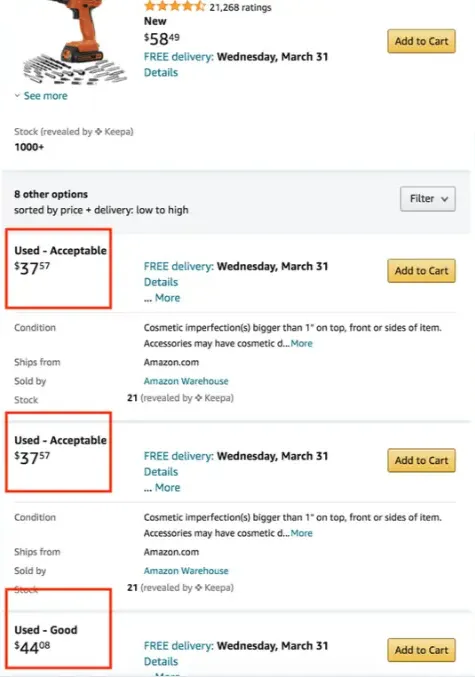
You create your own listing, set the price, handle fulfillment (packaging and shipping), and provide customer service. This method gives you more control over pricing and profit margins, but it requires more effort on your part.
If you’re just starting out with a few items, selling directly might be the simpler option.
Important note: The next steps in our how-to-sell used products on Amazon guide will be for merchants who sell directly, not using the Amazon Renewed Program or Amazon Trade-in program.
Step 2: Find used items
Now, you understand the market of used items on Amazon. The next step in how to sell used items on Amazon is finding some treasures to sell! Here are some things to consider:
2.1. Factors to consider used items
When sourcing used items, several factors need to be considered to ensure they will sell well on Amazon:
- Demand: You need to research what kind of used items are selling well on Amazon. Look for items with a good sales history and positive reviews (Some tools like Jungle Scout or Helium 10 can help)
- Profit margin: It is vital to consider the selling price of similar used items on Amazon and factor in the costs of acquisition, shipping, and Amazon fees (We will explain more clearly in the step deciding price for used items)
- Condition: It is vital to choose items that are in good condition and meet Amazon’s specific guidelines for your chosen category (refer back to Section 1.2).
- Storage space: Consider the size and quantity of the items you plan to sell. Do you have room to store them before they sell?
- Competition: How many other sellers are offering similar items? High competition can drive down prices and make it harder to stand out.
2.2. Places to find used items
Once you know what kind of items you’re looking for, we’ll move on to one of the most important actions in the how to sell used items on Amazon journey, which is finds items. Here are some of the best places to find used inventory for your Amazon store, such as:
2.2.1. Garage sales and thrift stores
There are classic treasure-hunting grounds perfect for finding used items. Arrive early for the best selection and be prepared to bargain.
2.2.2. Online marketplaces

Facebook Marketplace, Craigslist, and OfferUp are all excellent platforms to find sources for selling used items on Amazon.
Pro tips:
- Use filters on these platforms to narrow down your search and find items within your budget. You should Look for listings with clear descriptions and multiple photos.
- Be careful of the seller’s reputation and always meet in a public place when making transactions. In fact, there have been many cases of fraud when buying and selling through online marketplaces.
2.2.3. Retail stores (Clearance Sections & return bins):
Retailers often have clearance sections with heavily discounted items. You might find brand-new items with slightly damaged packaging that can be listed as “Used – Like New” on Amazon. Some stores also allow you to purchase items from their return bins – these can be a goldmine if you’re good at spotting valuable items!
Pro tip: Check clearance sections regularly and be familiar with store return policies before attempting to purchase return bin items.
2.2.4. Wholesalers
Liquidation sales from closing businesses or overstocked merchandise from wholesalers can be a good source of inventory. However, this method requires a larger initial investment.
Pro tips:
- Build relationships with wholesalers and negotiate bulk purchase discounts.
- Be sure you understand the condition of the merchandise before buying.
2.2.5. Other places
In addition to the popular places mentioned above, there are some others that you can consider to find sources for your how to sell used items on Amazon journey, which are:
- Your own stuff!: Don’t forget to declutter your own home! Electronics you’ve upgraded from or books you’ve read can all be turned into cash on Amazon.
- Social Media Groups & Forums: There are online communities dedicated to buying and selling used items. Join relevant Facebook groups or search for forums where people sell things they no longer need.
Step 3: Setting up your Amazon seller account
To continue how to sell used items on Amazon, you’ll need to establish yourself as a seller. Here’s a breakdown of the account setup process:
3.1. Choose the types of seller accounts
Amazon offers two main account types for sellers: Individual and Professional. The best choice for you depends on your selling volume and business goals. Here’s a table summarizing the key differences between Individual and Professional seller accounts:
Feature | Individual seller account | Professional seller account |
Selling Volume | Less than 40 items per month | More than 40 items per month |
Monthly Fee | No | Yes (variable fee) |
Selling Fees | Per-item fee | Per-item fee + monthly subscription |
Selling Limits | Lower | Higher |
Advanced Features | Limited | Full access |
- Individual seller account: This is Ideal for casual sellers with a limited number of items (less than 40 per month). Individual sellers have a lower selling limit and may not be able to access all of Amazon’s selling features.
- Selling fees: You’ll pay a per-item fee for each item you sell, which includes a closing fee and a variable selling fee that depends on the product category.
- Professional seller account: It is designed for businesses and high-volume sellers who plan to list more than 40 items per month. Professional sellers have higher selling limits (such as access to advanced selling tools and reports, and the ability to display their business name on product listings)
- Selling fees: Professional sellers pay a monthly subscription fee in addition to per-item closing fees and variable selling fees.
Pro tip: Amazon may have additional requirements or limitations based on your location and the products you plan to sell. Be sure to review Amazon’s Seller Central information for the latest details and any changes to their seller account options.
3.2. Create an account and fill the required information

Once you’ve chosen your seller account type, you need to head over to Amazon Seller Central to begin the registration process. Here’s a detailed guide to help you through the process:
- Go to Amazon Seller Central: On the Amazon Seller Central page, click on Sign Up.
- Choose your account type: Based on your expected sales volume, select whether you want an individual or professional account.
- Enter your business information: Provide your business name, address, and contact information. If you’re registering as an individual, you’ll use your personal information.
- Provide bank account details: Amazon requires your bank account information to deposit your earnings. Ensure the bank account can receive ACH deposits.
- Tax information: You’ll need to provide your tax identification number. For individuals, this is usually your Social Security Number (SSN). For businesses, use your Employer Identification Number (EIN).
- Identity verification: Amazon will verify your identity using the documents you provide. This may include a scanned copy of your ID (such as a passport or driver’s license) and a recent bank statement or utility bill.
Pro tip: We recommend you take your time to set up a comprehensive and appealing seller profile. First impressions matter, and a well-crafted profile can build trust with potential customers.
Step 4: Listing our used items on Amazon
Now, come to the next step of how to sell used items on Amazon journey: Listing items.
When selling a used item on Amazon, you won’t create a new listing. Instead, you’ll find an existing listing for the same product and add your offer under a “used” condition. Amazon does not allow multiple listings for the same product in new and used condition.
Here’s a step-by-step guide to listing used items for sale on Amazon:
- Find the existing product listing:
- Go to Manage Inventory > Add a Product
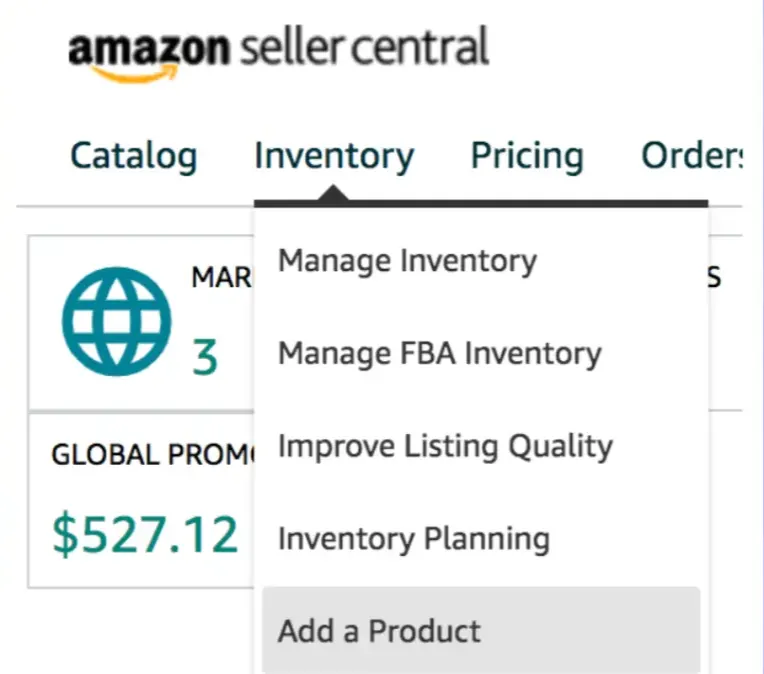
- Paste the ASIN of your used item into the search bar.

- The product details will appear.
- Specify your offer:
- Click on “Sell this product”.
- On the Offer page, enter details about your used item:
- Price: Set your selling price ((We will state details on how to decide price in step 5)
- Condition: This is important! Choose the option that best describes your item’s condition according to Amazon’s guidelines (refer to the guidelines you mentioned earlier).
- Condition note (Optional): Add details about any minor imperfections or wear.
- Fulfillment: Decide how you’ll fulfill orders. Wonder which fulfillment method is ideal for you? Step 6 of our how to sell used items on Amazon guide will give you a clear answer

Step 5: Price your used items
Are you contemplating the question, “How do I sell used items on Amazon successfully?”. It’s time for you to devote special attention to pricing
5.1. Research the market value
Before setting your price, it’s essential to understand what similar used items are selling for on Amazon. Here’s how to conduct your research:
- Search for similar listings: Search for your used item on Amazon using relevant keywords and filters to narrow down the results to similar used items in the same condition.
- Analyze completed listings: Don’t just focus on currently active listings. From our experience, checking the “Sold” listings can help you see the actual prices at which similar items have recently sold. This will give you a more accurate picture of the current market value.
- Use tracking tool: Tracking historical pricing data for used items on Amazon can help you identify trends and determine the optimal pricing window for your items. Luckily, there are many price tracking tools on the market, such as Keepa, Earny, CamelCamelCamel, and PriceSpy. We see that CamelCamelCamel is an ideal option. It’s completely free. However, it still offers a comprehensive view of price history (including data for used items) like other expensive tools. It is also easy to use.
5.2. Consider the item’s condition
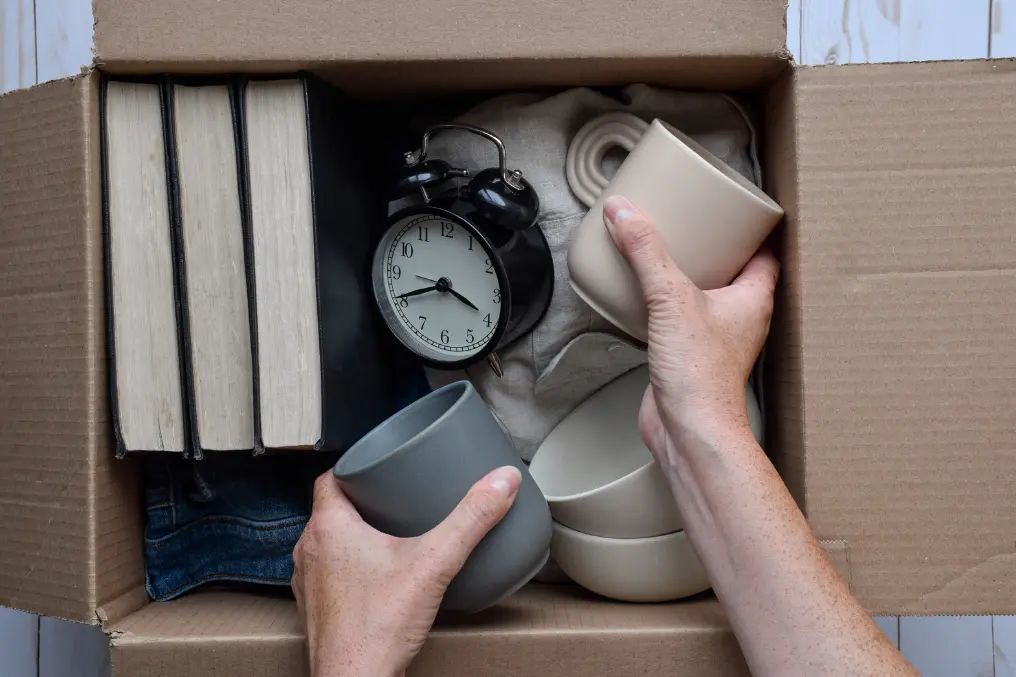
When selling used items on Amazon, the condition of one significantly impacts its market value. Here’s a breakdown of how condition typically affects pricing:
- Used—like new: Items in this category are typically priced close to the price of a new item, with a slight discount to reflect their pre-owned status.
- Used—very good: Items in this condition may be discounted by 10-20% compared to their new counterparts.
- Used—good: Items in this category will receive a more significant discount (20-40% off new), especially if they have noticeable wear and tear.
- Used—acceptable: Due to their significant wear and tear, these items will have the steepest price reductions (40% or more off new).
5.3. Calculate your minimum profit margin
While researching market value is important, you also need to factor in your bottom line when selling used items on Amazon. Here’s how to calculate your minimum acceptable profit margin:
- Estimate selling fees: Use Amazon’s fee calculator tool to estimate the total selling fees you’ll incur for your item. This includes closing fees, variable selling fees based on the product category, and any additional fees like fulfillment fees if you’re using Fulfillment by Amazon (FBA).
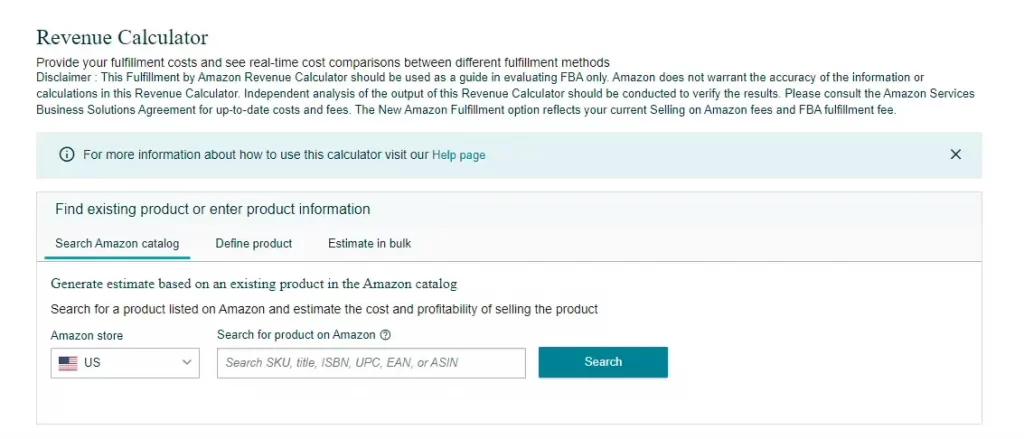
- Consider optional selling costs: Factor in any additional costs associated with selling your item, such as packaging materials, printing shipping labels, or storage fees if you’re using FBA.
- Set your minimum profit: Decide on the minimum profit you want to make on each sale. This will depend on your overall business goals and the profit margins you’re comfortable with.
Step 6: Fulfill your orders
Once a buyer purchases your used item, it’s time to ensure it gets delivered to them promptly and safely. Here, you have two main fulfillment options on Amazon: FBA (Fulfillment by Amazon) and FMB (Fulfillment by Merchant).
6.1. Fulfillment by merchant (FBM)
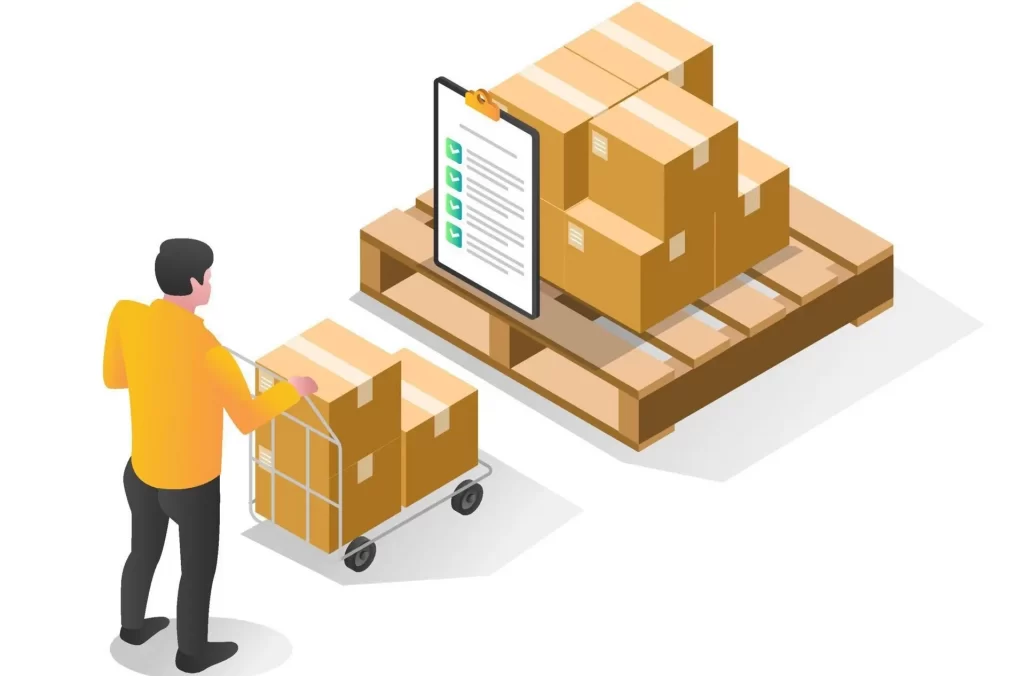
With FBM, you take the reins on the entire fulfillment process. This means you’re responsible for everything from packaging to shipping and customer service related to order tracking and delivery issues.
Benefits of FBM:
- Cost-effectiveness: You avoid FBA storage and fulfillment fees, which can be a significant advantage, especially for:
- Small and lightweight Items: For example, used books or video games typically have lower shipping costs that you can manage yourself.
- Limited inventory: If you’re just starting out selling used items on Amazon and have a small number of items, FBM can help you keep costs down.
- Control over the process: You have complete control over packaging materials, shipping methods, and customer service interactions. This allows you to:
- Personalized packaging: You can add a touch of personality to your used items with custom packaging or a handwritten thank-you note.
- Build relationships: By handling customer service inquiries directly, you have the opportunity to build rapport with buyers and potentially turn them into repeat customers.
Drawbacks of FBM:
- Time commitment: FBM requires a significant investment of your time and effort. You’ll need to:
- Package orders: Securely packaging each item for shipment can be time-consuming, especially if you have a high volume of orders.
- Ship orders: Researching shipping rates, purchasing postage, and scheduling pickups can add up quickly.
- Handle customer service: Responding to customer inquiries about order tracking, delivery delays, or missing items takes time and attention.
- Limited tracking options: With FBM, you may be using various carriers (USPS, FedEx, UPS) depending on your chosen shipping method. Tracking options can be less robust compared to FBA, which can lead to customer frustration if packages are delayed or lost.
In short, FBM is a good option for:
- Sellers with a small volume of used items, particularly lightweight items with affordable shipping options.
- Sellers who want to control the entire fulfillment process and potentially save on costs.
Pro tip: When selling used items on Amazon with FBM, you should invest in high-quality packing materials like sturdy boxes, bubble wrap, and packing peanuts to ensure your used items arrive safely. Presentation matters, so take the time to package your items professionally.
6.2. Fulfillment by Amazon (FBA)
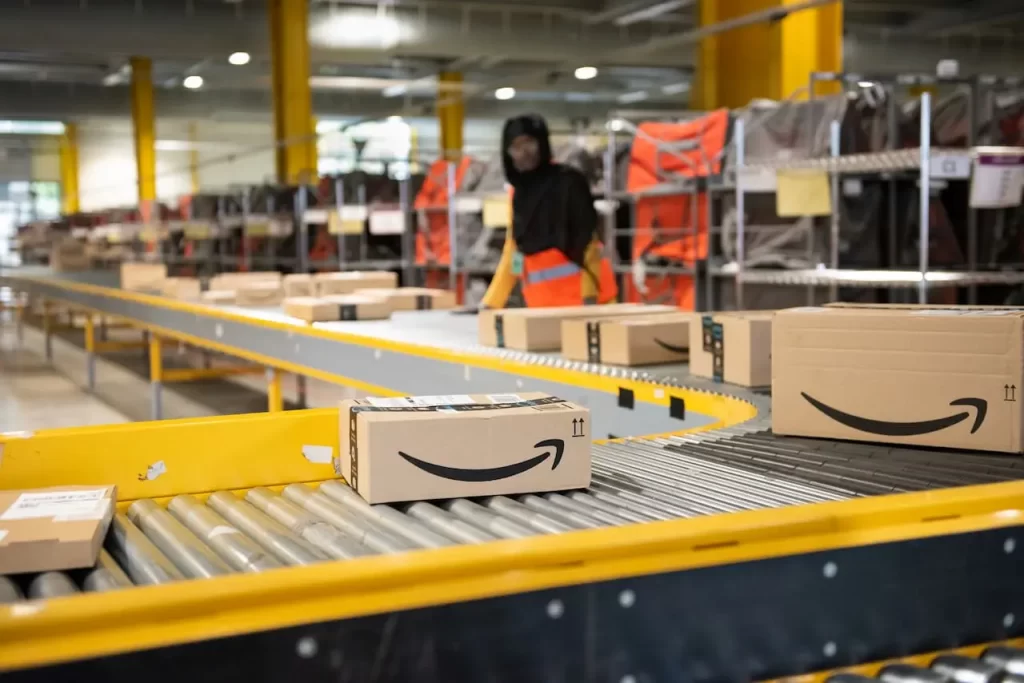
When selling used items on Amazon with FBA, you outsource the fulfillment process to Amazon’s vast network. Here’s how it works:
- Send inventory to Amazon: You’ll send your used items to Amazon fulfillment centers. Ensure you properly label and package your inventory according to Amazon’s guidelines to avoid delays.
- Amazon takes over: Once your inventory arrives at the fulfillment centers, Amazon takes care of everything:
- Storage: Your items are stored securely in Amazon’s warehouses until they are ordered.
- Picking & packing: When a customer orders your item, Amazon efficiently picks it from the warehouse, packages it securely, and prepares it for shipment.
- Shipping: Amazon leverages its network of carriers to ship your items to customers, often with fast and free shipping options.
- Customer service: Amazon handles most customer service inquiries related to order tracking, delivery issues, and returns for FBA orders (though you can set up preferences for some communication).
Benefits of FBA
- Convenience: FBA is a major time-saver. You can focus on sourcing great used items and listing them on Amazon, while Amazon takes care of the rest.
- Increased sales potential: FBA sellers qualify for Amazon’s Prime free shipping program, which can be a significant sales booster. Studies show that 67% of customers are more likely to purchase items with the Prime free shipping badge.
- Improved customer satisfaction: Since Amazon uses reliable carriers and offers robust tracking options, customers can easily follow their packages and have them delivered quickly.
Drawbacks of FBA
- Higher costs: FBA fees can add up, especially for bulky or slow-moving inventory.
- Less control: While Amazon typically provides excellent service, there may be situations where you have limited ability to intervene in case of customer issues.
In short, FBA is a good option for:
- Sellers with a larger volume of used items, especially those with consistent sales velocity.
- Sellers who want to leverage Amazon’s Prime free shipping program and increased visibility to potentially grow their sales.
Pro tip: Proper inventory management is essential for maximizing profits with FBA. You need avoid overstocking to minimize storage fees. We highly recommend you use Amazon’s inventory management tools such as Amazon Listing tools from LitCommerce to track your stock levels, sales velocity.
List Smart & Earn with Amazon Listing Tool
With LitCommerce, you can effortlessly manage your Amazon inventory and bulk listings. Take advantage of Amazon’s extensive reach and boost your sales today!
Step 7: Handle return and refund
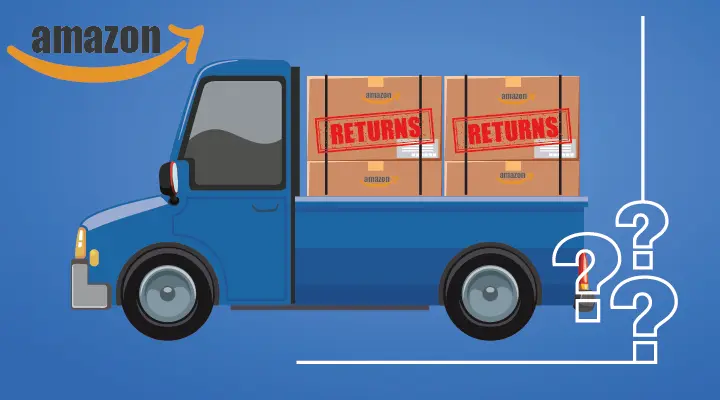
Even with the best descriptions and photos, sometimes returns happen in your journey of how to sell used items on Amazon. Here’s how to handle returns and refunds professionally to maintain customer satisfaction and a positive seller reputation on Amazon.
In fact, Amazon has a customer-centric return policy that allows buyers to return most items within 30 days of receipt. Sellers are generally responsible for covering return shipping costs unless the return is due to an error on your part (wrong item shipped, damaged item, etc.).
And, here are the return process you should know:
- RMA (Return merchandise authorization): When a buyer initiates a return request, you’ll receive a notification through Seller Central. You have the option to approve or reject the return request. Always approve legitimate return requests to avoid negative feedback.
Return communication: Communicate clearly with the buyer throughout the return process. Provide instructions on how to return the item and an estimated timeframe for processing the refund once you receive it back. - Item inspection: Once you receive the returned item, inspect it carefully to determine its condition. If the item is in the same condition as it was shipped, process a full refund to the buyer.
- Partial refunds: In some cases, you may offer a partial refund for an item with minor damage or signs of wear that were not mentioned in the original listing. Always communicate clearly with the buyer about the reason for the partial refund and offer them the option to return the item for a full refund if they’re not satisfied.
Step 8: Optimize your sales performance
Now, we have reached the final step of the process of how to sell used items on Amazon. Once you’ve mastered the basics of listing, fulfilling, and providing customer service for your used items, it’s time to focus on optimizing your sales performance. Here are two key strategies to consider:
8.1. Marketing and promotion

While Amazon is a massive online marketplace, there are still ways to make your used item listings stand out and attract more potential buyers. Here are some tactics to consider:
- High-quality photos & videos: Invest in high-resolution photos from multiple angles that showcase the condition of your used items. You can include a short video to provide a 360-degree view of the item, especially for more complex products.
- Amazon PPC Ads: Consider running Amazon Pay-Per-Click (PPC) advertising campaigns to increase your listing visibility in search results. With PPC ads, you only pay when someone clicks on your ad. This allows you to target specific demographics and keywords to reach your ideal customers.
- Lightning deals & seller promotions: Occasionally, Amazon offers promotional opportunities like lightning deals or seller promotions. These can be a great way to generate interest in your used items and boost sales in a short period.
In our opinion, the most impactful marketing tip for selling used items on Amazon is investing in high-quality photos and videos. This visually showcases the condition of your items, boosting buyer confidence and click-through rates. Furthermore, this tip does not require you to spend any extra money
8.2. Analyzing sales data
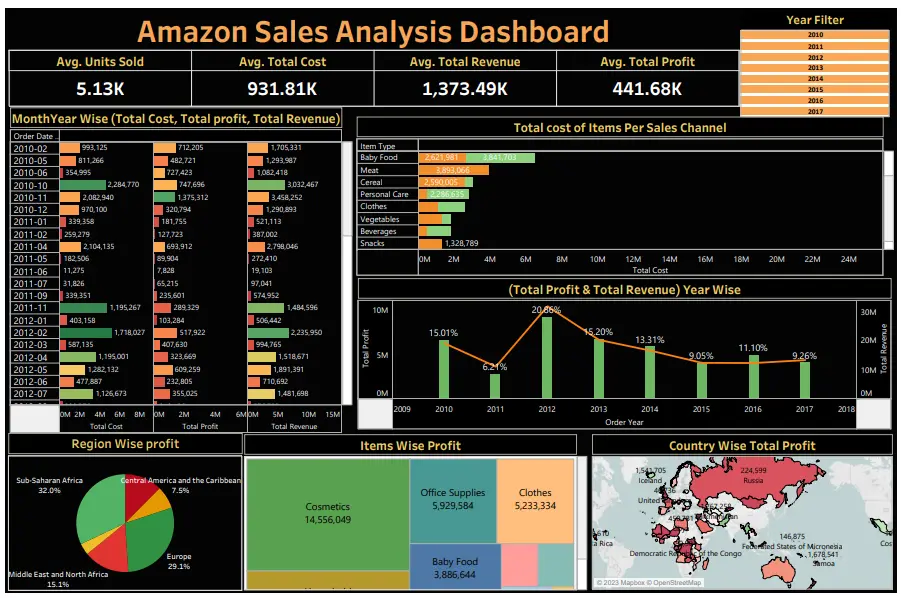
Seller Central provides a wealth of sales data that can be used to make informed decisions about your listings and overall business strategy. Here’s how to leverage sales data effectively:
- Track profit margins: Don’t just focus on sales volume. Factor in your selling costs (FBA fees, packaging materials, etc.) to calculate your profit margin for each used item. This will help you identify areas for improvement and ensure you’re making money on your sales.
- Customer reviews & feedback: Pay close attention to customer reviews and feedback. Positive reviews can significantly boost your sales, while negative reviews can deter potential buyers. Address negative feedback promptly and professionally, and use constructive criticism to improve your listings and customer service approach.
- Identify sales trends: Analyze your sales data over time to identify trends. Are there certain seasons or times of year when your used items sell better? This information can help you plan your sourcing and marketing strategies accordingly.
When analyzing sales data, the most important metric is sales conversion rate combined with profit margin. This duo reveals how effectively your listings convert interest into sales while ensuring you’re making money on each transaction.
Tired of manually managing your used item sales on Amazon? Discover how Amazon automation can streamline your business and boost profits.
So, What Are The Best 3 Used Items to Sell on Amazon?
Here’s our take on the top five categories for selling used goods on Amazon, based on our own experience and research:
1. Books
Books have always been a popular choice for used item sellers, and for good reason. According to Credence research, the global market for used books was worth $25.59 billion in 2023 and is expected to grow to $48.49 billion by 2032. This growth is fueled by a love for reading, cost-conscious consumers, and the ever-expanding collector market.
Textbooks, especially for niche subjects or older editions, can be goldmines. On Reddit, we once found a near-mint copy of a rare psychology textbook for a few bucks and sold it for over $145 (as you can see in the picture below).
For fiction, first or special editions or signed copies by popular authors hold significant value. You see, someone is willing to pay 4.5 times the original value to buy a special edition of The Lord of the Rings. One person even spent $285 just to own the first edition of God Bless You!

Useful tips:
- When selling used books on Amazon, you need to be honest about the book’s condition. A dog-eared paperback, for instance, won’t fetch the same price as a pristine hardcover.
- In addition to second-hand physical books, you can sell Amazon Kindle devices – a device that supports ebook reading. Learn more about Kindle in our article: How to sell used books on Amazon.
2. Second-hand video game
The video game industry is a multi-billion-dollar market, with used video games representing a substantial segment. The size of the second-hand game platform market was valued at a whopping $96.67 billion in 2023. Analysts predict this market to nearly double in size, reaching $196.61 billion by 2030.
When choosing video games for selling used items on Amazon, we recommend starting with retro consoles and classic games. These two items, especially those in good condition with original packaging, can be surprisingly valuable.
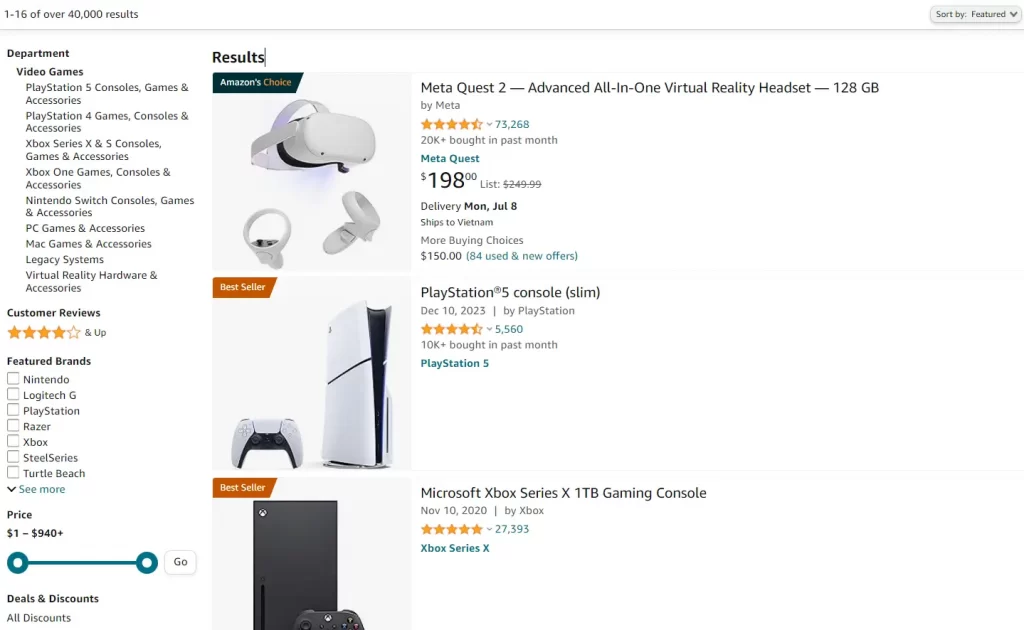
3. Collectible
Did you know that the collectibles market in 2024 is predicted to be $594.2 Billion? The market for collectibles is diverse and thriving, driven by nostalgia, rarity, and the desire for tangible pieces of history or culture.
Here are some specific niches within collectibles that can be highly profitable on Amazon:
- Vintage toys: Nostalgic toys from the 80s and 90s, particularly sealed or well-maintained ones, can fetch high prices.
- Trading cards: Sports cards, Pokémon cards, and other collectible card games can be highly valuable, especially rare and first-edition cards.
- Sports memorabilia: Signed jerseys, game-used equipment, or trading cards of star athletes can be valuable depending on rarity and authenticity. Fun fact: As of now, the most expensive sports memorabilia (Topps Mickey Mantle card) costs $12.6 million. And, it’s not uncommon for people to pay several hundred dollars to own a sports memorabilia, as you can see in the picture below.
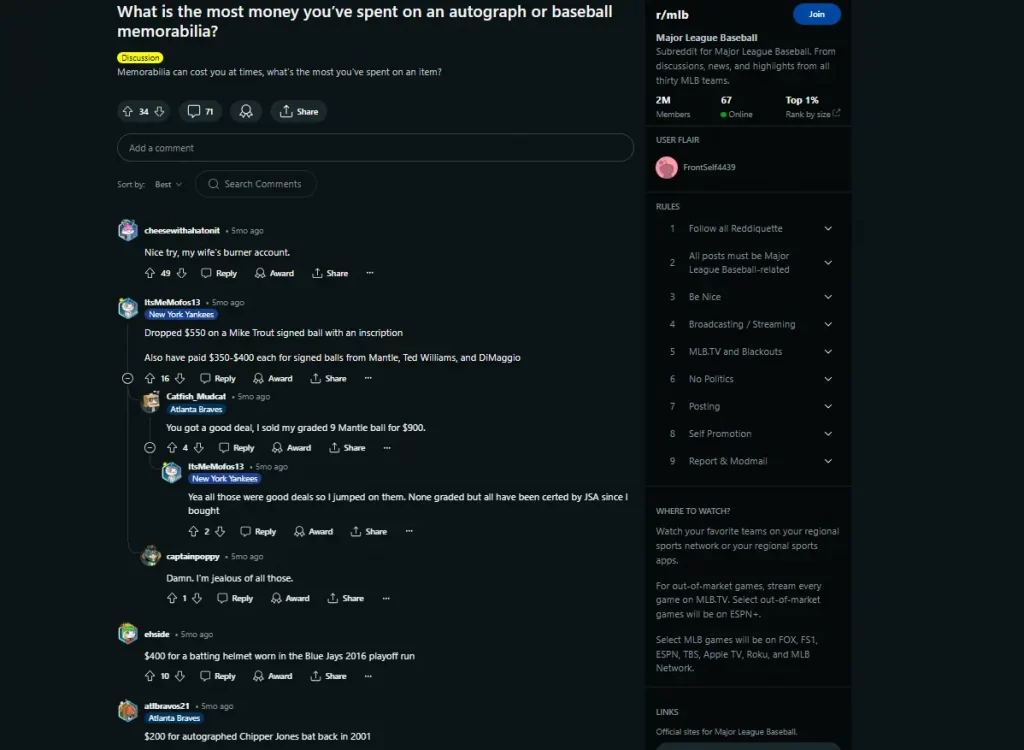
How to Sell Used Items on Amazon: FAQs
No, Amazon generally doesn’t allow selling used clothes directly. But, there are programs like Amazon Renewed for specific sellers to list inspected pre-owned items. Consider other platforms like eBay or Facebook Marketplace for used clothes. To sell used electronics on Amazon, you need to: Yes, you can sell one item on Amazon! They offer two account options: Individual for $.99 per sale and Professional for a monthly fee. Consider fees and effort vs. selling elsewhere for a single item. Yes, reselling on Amazon involves fees. There are two seller plans:
Selling Used Items on Amazon is Big Money!
In conclusion, after exploring this comprehensive guide on how to sell used items on Amazon, it is evident that there is a wide range of opportunities available on this platform.
From the multitude of used items you can sell to the various methods for selling, delivering, and promoting your products, Amazon offers ample potential for success. With diligence, adherence to instructions, and a touch of luck, it is entirely possible to achieve significant financial gains through selling used items on Amazon.
Rather than bidding farewell, we encourage you to stay engaged with fascinating insights related to online business by following Retail blog of LitCommerce. It is a valuable resource that can provide further knowledge and guidance to help you thrive in the world of eCommerce.
If you have any questions, please contact us for answers

